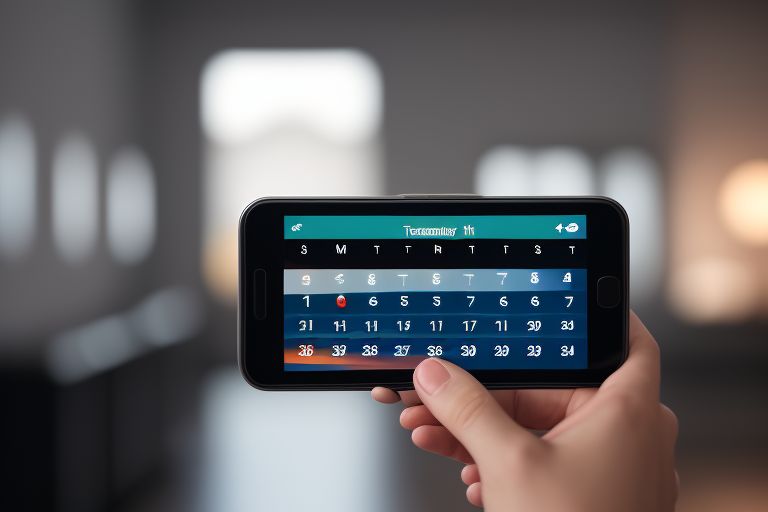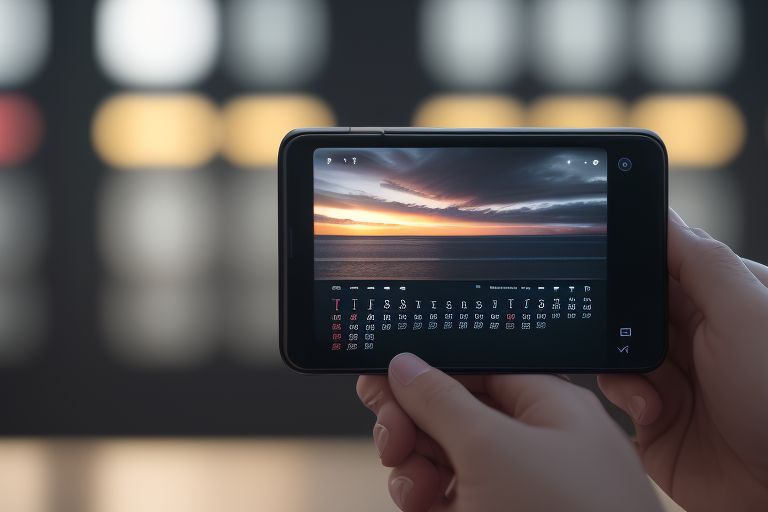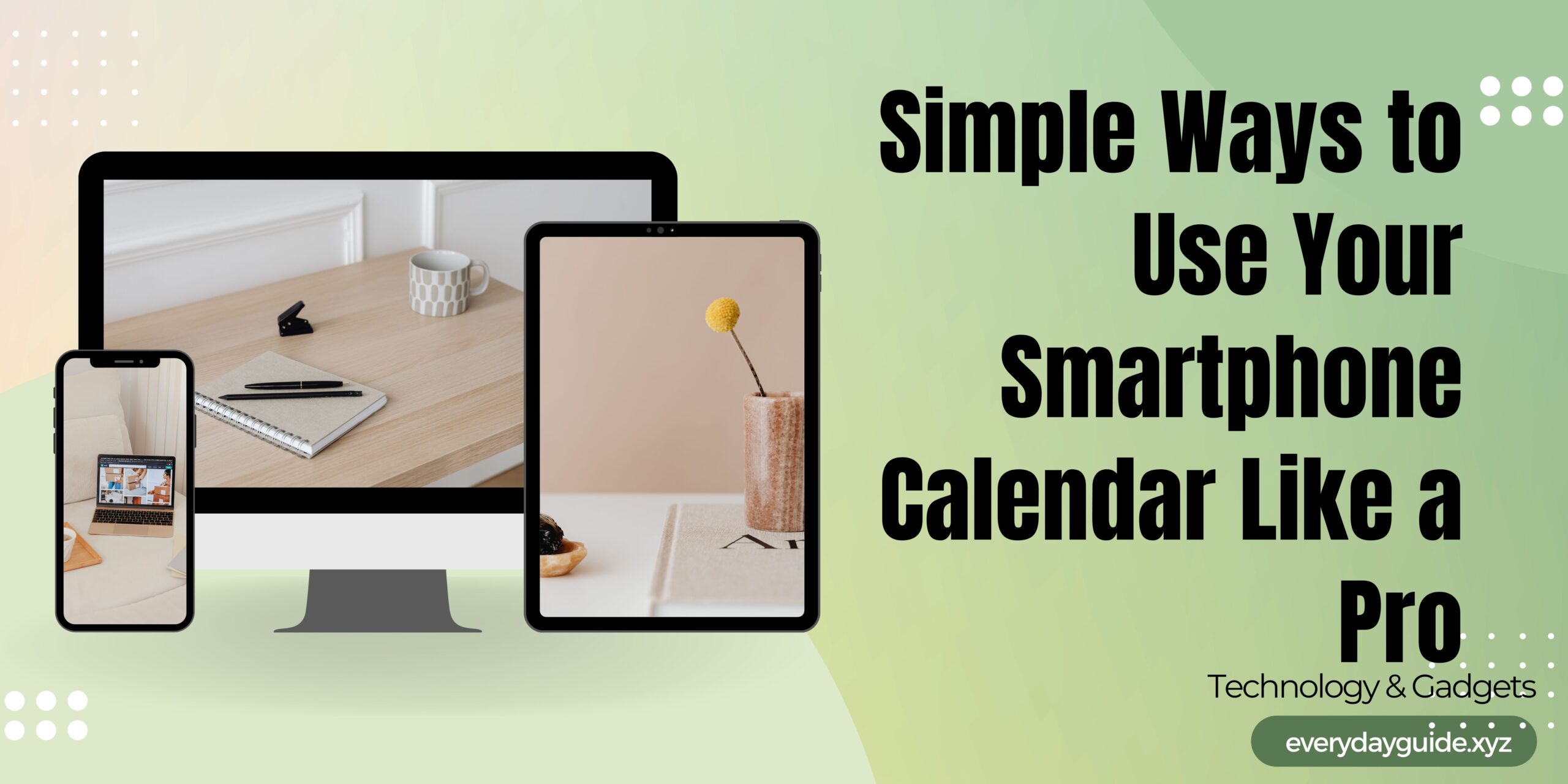In the fast-paced world of technology, being well-versed in your smartphone calendar is so important for keeping life under control and getting things done. Busy professional working long hours, student juggling between academia and part-time jobs or just someone who wants to make better use of their time, your smartphone calendar is a superpower. In this guide, we will explore straightforward methods to help you use that calendar more intelligently so that it can work like your very own resourceful sidelining life and making sure you are ahead of the game. We will touch on pretty much everything you need to know about how to use a smartphone calendar: from simple setup features through all the way advanced level capabilities for you personally and, before this piece ends, hopefully for your team too.
How to Optimize Your Calendar for Maximum Efficiency

The key to leveraging such a powerful tool like your smartphone calendar is in the setup. An organized calendar might be the difference between going crazy and feeling organised. You need to pick a calendar app that is tailored to your requirements — at most times, a built-in calendar app is pre-installed on our smartphones but if you are not happy with the default offering, there are hundreds of third-party options out there giving you more features and settings.
After you’ve chosen your app, make sure to tweak the calendar view properties. They come as daily, weekly and monthly views, each designed to show different things. The daily view perfect for planning your day in more detail, and the weekly view allows you to review all of your upcoming engagements. One-Month View for Aggregating Trends and Aspects of Your Routine Test these views out for your life and workflow.
How to Master Color-Coding Your Schedule: A Shareable Time Management Technique
Color coding is one of the best and least utilized, features in a smartphone calendar. In this simple way, you get away from what the calendar has always been — a flat list of events — and into something visually intuitive. As soon as you know what your key colors are, you take a look at your current week instantly recognize which areas of activity or life your commitments are serving.
Developing a Good Color-Coding System
Identify the main categories in your life to set up an efficient color-coding system. Work, personal appointments, family obligations, nutrition and fitness, social life and personal development. Color each category differently You might, for instance, assign blue work-related entries, green personal appointments and time off, red important deadlines and yellow social engagements.
Stick with this process consistently, and you will develop a sense for how you tend to distribute your time (it will become like second nature), which can help keep things in alignment and illuminate what needs more focus.
Using Advanced Features to Boost Productivity
Repeating appointments — One of the best time-savers on smartphone calendars is repeating events. These are things like, having team meetings once a week, paying bills on the first day of every month etc… most to-do apps will have a recurring task feature that you can implement. This way you only need to set these up once and they are always on your calendar without having to type them out beforehand each time.
Alerts & Reminders: Stay in Touch
Customizing notifications and reminders is important to ensuring that you make it on time to everything in your schedule. With most calendar apps, you can have multiple reminders for a single event.this could be crucial for essential appointments or deadlines. One trick is to set a reminder the day before, 1 hour before, or even 15 minutes before all important events.
With that is built support for fetching reminders based on locations from existing lists (or creating new lists), which are supported in Evernote 3.0+.
Location-based reminders — Have you tried modern smartphone calendars? Because geo fencing this feature, it allows you to set reminders that can be initiated when you get there or leave a location. For instance, when leaving the office, you can have a reminder notification to pick up dry cleaning if this is what you need in your way back home.
Also Read More:
- Turn Your Phone into a Powerful Study Tool with These Tips
 In this age of digitalisation, smartphones are so ubiquitous that we tend to overlook their power as a study tool. This extensive guide will take you through creative hacks to supercharge your phone and make it an irreplaceable academic assistant. From… Read more: Turn Your Phone into a Powerful Study Tool with These Tips
In this age of digitalisation, smartphones are so ubiquitous that we tend to overlook their power as a study tool. This extensive guide will take you through creative hacks to supercharge your phone and make it an irreplaceable academic assistant. From… Read more: Turn Your Phone into a Powerful Study Tool with These Tips - 7 Smart Tips to Balance Work and Family Life
 Work-life balance is a huge issue for most of us, as pace of life increases with time. Balancing your work and life is an important point but finding some useful hacks to keep pace with both. By following the right strategies,… Read more: 7 Smart Tips to Balance Work and Family Life
Work-life balance is a huge issue for most of us, as pace of life increases with time. Balancing your work and life is an important point but finding some useful hacks to keep pace with both. By following the right strategies,… Read more: 7 Smart Tips to Balance Work and Family Life - 9 Simple Strategies for Handling Tantrums on the Go
 Spending time with your family is a rare opportunity to improve this bond, memorize and have quality moments together. On the other hand shooting these moments and making them fun for everyone is a challenge. Regardless of whether you have infants,… Read more: 9 Simple Strategies for Handling Tantrums on the Go
Spending time with your family is a rare opportunity to improve this bond, memorize and have quality moments together. On the other hand shooting these moments and making them fun for everyone is a challenge. Regardless of whether you have infants,… Read more: 9 Simple Strategies for Handling Tantrums on the Go - 10 Easy Ways to Make Family Time More Fun
 Dealing with tantrums as a parent can be difficult to manage at home. However, public temper tantrums may seem an entirely different variety. This is especially challenging when tantrums occur on-the-go: while running errands, driving to a destination, or shopping in… Read more: 10 Easy Ways to Make Family Time More Fun
Dealing with tantrums as a parent can be difficult to manage at home. However, public temper tantrums may seem an entirely different variety. This is especially challenging when tantrums occur on-the-go: while running errands, driving to a destination, or shopping in… Read more: 10 Easy Ways to Make Family Time More Fun - Fun and Fast Activities for Kids During Wait Times
 It happens to the best of us as parents: waiting in a doctor’s office, delayed at the airport, or stuck in line with kids who are anxious and on edge. Yes, that can be tough but it does not have to… Read more: Fun and Fast Activities for Kids During Wait Times
It happens to the best of us as parents: waiting in a doctor’s office, delayed at the airport, or stuck in line with kids who are anxious and on edge. Yes, that can be tough but it does not have to… Read more: Fun and Fast Activities for Kids During Wait Times
Syncing & Sharing — Collaborative Calendar MGMT
The Power of Cloud Syncing
For calendar management, cloud syncing is simply gold. When your calendar syncs across your devices, you can be confident that what is on the printed page exists in all possible places, whether a smartphone (like an iPhone), tablet or computer. Through a seamless integration, any changes update in real time and you can access your schedule from anywhere.

Sharing Calendars for Coordination
A good asynchronous communication medium for how you split time between family members or either among colleagues, outside of project teams. Most smartphone calendars enable you to share individual calendar or event streams with others. This can be incredibly useful for:
- Coordinating family schedules
- Planning team projects
- Hosting a social event with friends
- Controlling joint duties
- If you share calendars, don’t show more information than needed. Many apps provide the ability to set visibility levels for others, from full details to just free/busy status.
- Consolidating Calendars from Multiple Sources
Some people have separate calendars for work, home, and shared family calendars. Learning how to best integrate these schedules creates a full disclosure of your commitments but still keeps accountability firmly set in other life zones.
Leading AI and Smart Functions for Predictive Scheduling
AI-Powered Suggestions
Some modern smartphone calendars provide AI-driven analyses of your predilection to compare it with potential solutions and make recommendations. These might include:
Times: When You Normally Meet
travel time for events with location
Auto Event Creation from Email/Messages
These features can be really useful but make sure to check the AI suggestions and verify they match your taste and priorities.
- Smart Scheduling Assistants
- These days, youll find a few calendar apps such as smart scheduling assistants that can coordinate meet. These tools can:
- Schedule mutually acceptable time slots
- Propose For How Long You Should Conduct A Meeting
- Manage time zone differences with remote teams
- These features can save a ton of time, and cut down on the back-and-forth emails that frequently accompany schedule invites for group events or meetings.
Predictive Event Creation
Advanced calendar apps like Reclaim likely provide some sort of predictive event creation based on your habits and patterns. For instance, if you typically hit the gym every Tuesday evening, the app would prompt to make this a regular event. While this can be powerful, you have to keep in mind with scheduling control limitations and not let it make noises that are not always correct.
Linking with Other Tools to Sync your Calendar
- Task Management Integration
- For example, many productivity experts will tell you to bring your calendar into your task management app. This one integration allows you to:
- Plan your time in daily blocks of when you are going to do what.
- Sync calendar event with corresponding task or project
- View all commitments of your time and to-do list in one place
For instance, the to-do lists:Whenever a task in your to-do list needs a specific time and place for execution you can put that in a calendarPopular task management apps like Todoist or Asana or Trello often offer the feature of integration with calendars. Check out these integrations to bridge the gap between your scheduled events and task list.

Email and Calendar Synergy
Having your email connected to your calendar is a huge productivity enhancer. Most email clients support creating calendar events from emails directly. Use case: This is useful for especially,
- This is a quick way how you can add an appointment which was mentioned in emails.
- Creating process to have key conversations
- One-click event creation from email invitations
- Use this integration to save yourself the time transferring information manually from emails into your calendar.
- Note-Taking App Integration
- Combine a Calendar & Note-Taking App to Help You Prepare for and Review Events So now you can do all kinds of cool things with this integration such as;
- Calendar Events ○ Agendas or Talking points
- Building automatic post-meeting note templates
- Linking a calendar event to notes or documents related to the project
This can make your workflow much faster, and ensure you are always prepared on-time for your upcoming commitments whether those be depositions or court dates. Apps like Evernote or OneNote often include calendar integration functionalities which will pay dividends in short amount of time this will take to set up.
How to Time Block for Better Focus and Productivity
Understanding Time Blocking
- What is Time BlockingBasic in board-thumbnails concept of scheduling specific time slots for activities or types of work This method can help you:
- Spend time in things which are more important.
- Minimize context switching and increase concentration
- Be realistic about the time you have.
- 4) Schedule the Time in Your Calendar
- How to properly use time blocking:
- First, block out non-negotiable commitments like meetings and deadlines.
- Find the 3 most important tasks, allocate a specific time for each one of them
- Leave buffer time between blocks to take into account unexpected interruptions or overruns.
- Plan when you take your breaks and have a balance in the things you do throughout the day.
- Turns out there are two ways to go about time blocking: rigid and flexible.
Yes, time blocking has many strong points but it is even more powerful with a dose of just enough structure and flexibility. There are the people who want a structure for every minute and the others who need broader buckets of time for various types of activities.
It would be impossible to list every idea for time blocking like this, and I really think you need to experiment to see different levels of detail in your time blocks work best for you (both in productivity AND enjoyment). Just remember that the idea of a routine is to make you more efficient and feel less stressed, so this is not an exercise in making a harder set plan that could feel suffocating.
Using Calendar Analytics for Personal Insights
Understanding Your Time Usage
A lot of the more advanced calendar apps have started implementing analytics features that can give you some insight into how you’re actually using your time. These analytics can help you:
- Look for patterns in your schedule
- Identify Time-Wasters
- Make time for your priorities
- Types of Calendar Analytics
- Types of Calendar Analytics
- Categories of time (ie: work, personal, health)
- Most Popular Days/Time of Week
- Regular Meetups 3h (Tues / Fri)
- Hours on projects, or in meetings
- Acting on Calendar Insights
- What comes afteryou get some understanding of your timehone to back in?
- Getting mindful on your schedule work with your energy and flow of productivity.
- Pinpointing where you are possibly overcommitting features
- Identifying things you can delegate or that you do every day and putting in place systems to automate them
- Making time for important but non-urgent tasks like personal development or strategic planning
- The more often you track these analytics, the better prepared you are to always learn how to manage your calendar.
- For The Power User Who Wants More Calendar Customization
- Creating Custom Views
- Power users can improve their productivity by adding custom Work Week and other calendar views. These might include:
- Weekday (Monday to Friday) View
- Content of Project-specific views filtering for tagged events
- Stacked calendar views
- Play with custom views to see which setups give you the best insight on your data depending on the context or project.
- Utilizing Calendar Widgets
- You will be able to see your schedule at a glance using calendar widget in home screen. Depending on your needs, you might include widgets such as the following:
- Your next upcoming event
- Your daily schedule.scrollView a bit of your day
- A mini calendar to help reference a date quickly
- When these widgets are customized in some ways, then you can just take a look at your phone to know when it is time for what.
Keyboard Shortcuts and Quick Add
Most calendar apps have keyboard shortcuts or have some type of quick add option where you can quickly enter in an event. Knowing some of these shortcuts will greatly improve the speed at which you can manage your calendar. For example:
Natural language input (eg “Meeting with John next Tuesday at 2 pm”)
Keyboard Shortcuts to jump between views or create a new event
One-click adds — Add common event types with a single button click
By learning how to use these features like a pro, you can become quick at calendar management by spending less time doing admin chores.
How to Keep Your Calendar System Clean for Long-Term Success
Regular Calendar Audits
- Conduct regular calendar audits — Regularly audit your calendar to make sure it remains an effective tool. This process involves:
- Editing recurrent event series
- We can either archive or delete old events.
- Performing with your color-coded system and categories
- Testing shared calendars are valid
- Combining Specifics and Simplicity
- Although you may be tempted to put everything in your calendar, maximizing the information and minimizing the amount is important. Consider:
- Not putting the kitchen sink in an event title and saving additional details for event descriptions
- Using tags or categories instead of creating calendars for every part of your life
- Understanding whether or not the granularity in your calendar is improving productivity through self-evaluation
- Working with Common Naming Conventions
- Creating a pattern in your naming conventions for events frees up space on your calendar as you can quickly identify an event sans meeting details. Consider:
- Prefixing events with categories (Meeting:, Deadline:, Personal:)
- The title itself with some relevant info (eg: Project X Status Update with Team)
- Choosing a standardization for recurring events (i.e. Weekly Team Standup or Team Standup — Weekly)
- By being consistent with your event naming and structuring you are able to process your schedule quickly, more easily in up pops another valid reason for keeping things tight.
- Smartphone calendars are no good so don’t waste your time on them Conclusion: Your smartphone calendar is amazing
Conclusion
Still, mastering the smartphone calendar is a process of constantly refining its use to suit our individual needs. So roll up your sleeves and start reinventing your digital calendar, turning it from just a layered scheduling device to one of the strongest ways to keep you efficient and balanced in work-life using all these tips and tricks brought together for you.
Now, bear in mind that what makes your smartphone calendar a productivity weapon is not the features alone, but how you make these tools bend around you and your life. Play around with different methods, and be willing to tweak your system as your life changes, and take advantage of more advanced capabilities and integrations create a calendar workflow that best serves you.

